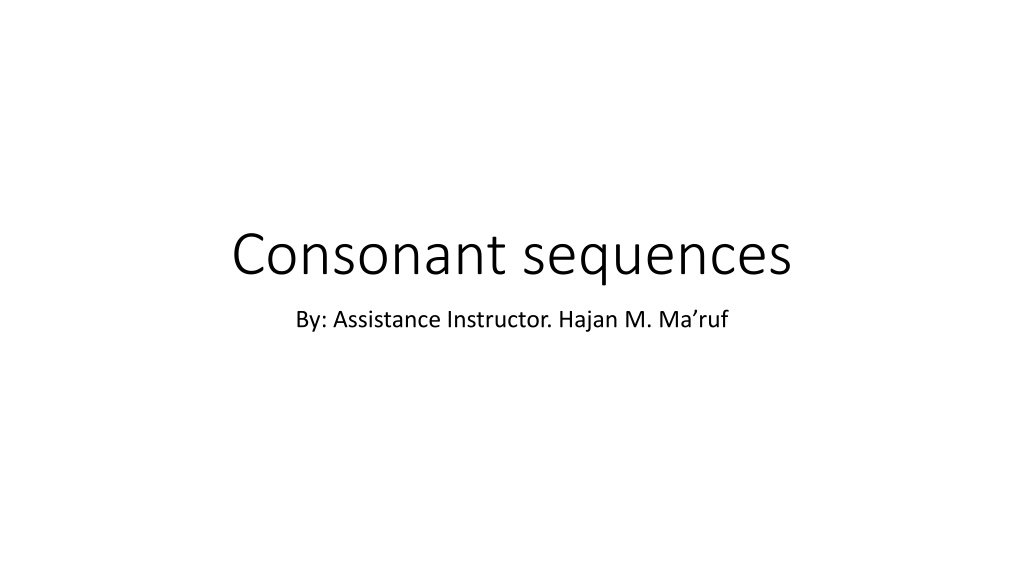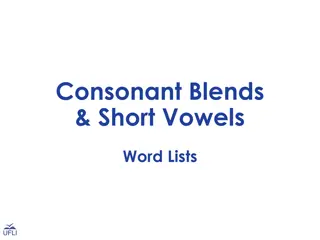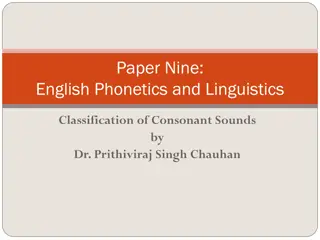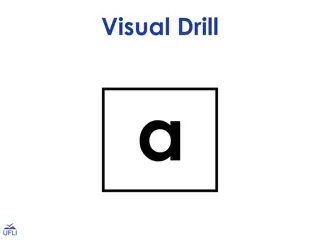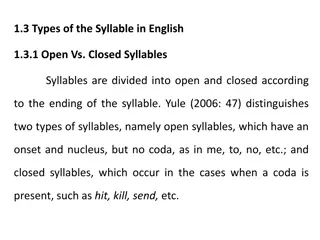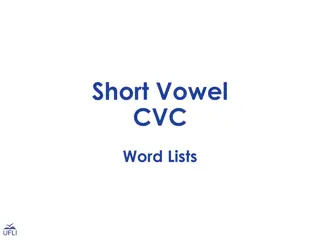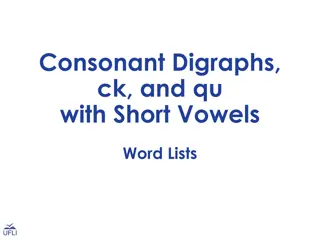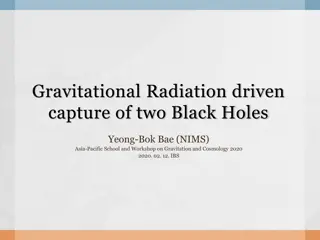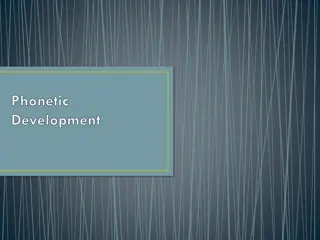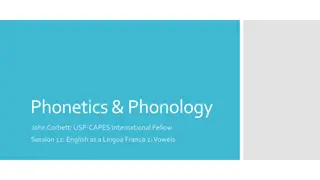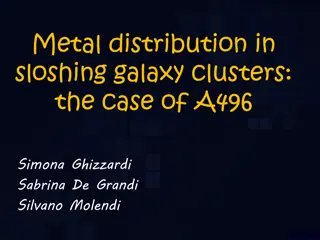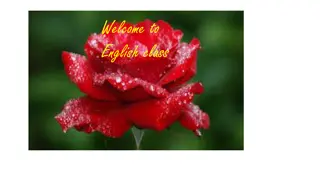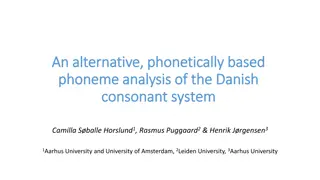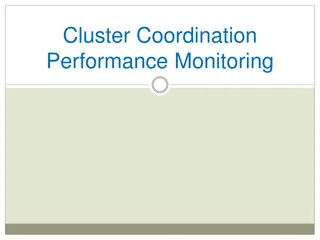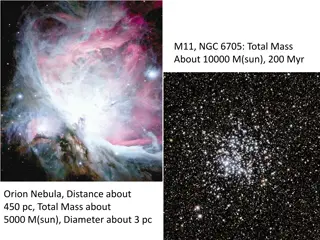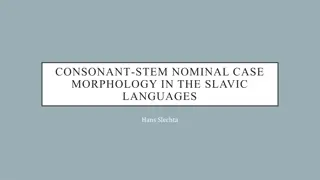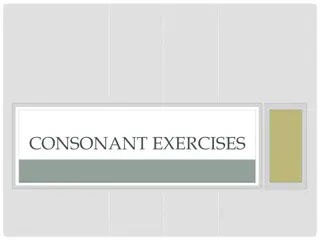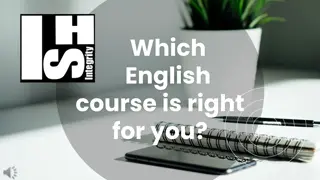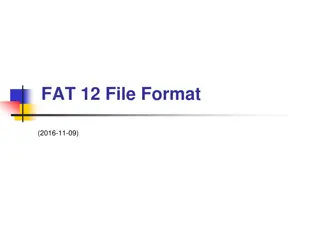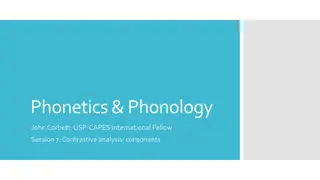Understanding Consonant Clusters in English
Consonant clusters are groups of consonants without vowels in between, found at the beginning, middle, or end of words. They play a crucial role in English pronunciation and word formation, with specific patterns and exceptions to consider. This guide provides insights into different types of consonant clusters and their positions within English words.
Download Presentation

Please find below an Image/Link to download the presentation.
The content on the website is provided AS IS for your information and personal use only. It may not be sold, licensed, or shared on other websites without obtaining consent from the author. Download presentation by click this link. If you encounter any issues during the download, it is possible that the publisher has removed the file from their server.
E N D
Presentation Transcript
Consonant sequences By: Assistance Instructor. Hajan M. Ma ruf
Consonant sequences or consonant clusters Consonant sequences or consonant clusters
What is consonant cluster ? Consonant :one of a set of sounds in which air from the lungs is seriously obstructed in the mouth, and which occur in similar positions in words. Basically, the consonant cluster is a combination or groups of consonants which come together in a word and have no vowel in between. These consonant clusters are sometimes also called as the consonant sequences. The essential part to consider is while you are reading out the word or the cluster you need to pronounce it individually. You would observe that in some consonant clusters the sounds get reduced or dropped. For example, /sp/ and /ts/ in the word spots or /spr/ in the word spring .
The Consonant Clusters in English So as to give a complete picture of initial (onset) and final (coda) clusters in English, which offers the practical list of some consonant clusters in English. The word, i.e. the syllable in English can begin with a vowel, with one, two or three consonants. No word in English begins with more than three consonants, thus the maximum number of segments in the word-initial consonant cluster is three. At the beginning of English words (syllables), in many cases, the first element is /s/ and the second consonant is approximant /l, r, w, j/
Positions of consonant clusters: 1. Initial Clusters in English : 2. Medial Clusters in English: 3. Final Clusters in English :
1. Initial Clusters in English: cc- These are of two main kinds: 1. s + one of /p,t,k,f,m,n,l,w,j/ Eg: spy. Stay ,sky, sphere, small, snow, sleep, swear, suit. 2. one of /p,t,k,b,d,g,f, , ,v,m,n,h/ + one of /l,w,r,j/ But not all of these sequences are found (e.g.*pw, *dl, do not occur in initial position) /p/+ /l,r,j/= play, pray, pure /t/ + /r,w,j/= try, twice, tune /k/ + /l,r,w,j/ =climb, cry, quite, cure
Sequences of two consonants initially one of /p,t,k,b,d,g,f, , ,v,m,n,h/ + one of /l,w,r,j/ /b/ + /l,r,j/ = blow, bread, beauty /d/ + /r,w,j/ = dress, dwell(rare), duty /g/ +/l,r/ = glass, green /f/ + /l,r,j/ =fly, from, few / / + /r,w/ =throw, thwart (rare) / / + /r/ = shriek /m/ + /j/ = music, mute /n/ + /j/ = new /h/ + /j/ =huge, human
1. Initial sequences: Start with /sp/: say a long /s/, then gradually close the lips for / p/ until they stop the /s-/sound. spy /spai/ , spur /sp ;/, spear/spi /, spare /spe /. Do not say * spai or *s pai. Start with /s/ and halt it by closing the lips. /st/ and /sk/ are begun by making a long /s/ and halting it by raising the tongue-tip (for /st/) or tongue-back (for /sk/) to cut off the friction. Try: stay /stei/, store /sto:/, star /sta:/, steer /sti / sky /skai/, scar /ska:/, score /sko:/, scare /ske /. Do not say /* stei/ or /*s tei/.
Onset and coda Onset and coda 1. Onset: the part of a syllable that comes before its vowel or nucleus, e.g. /st-/ in steam. 2. Coda: syllable that comes after its vowel, the nucleus, e.g. /-st/ in best. the part of the
S+/f, m, n, l/ In /sf/ (which is rare) the long /s/ is ended by the lower lip moving up to the upper teeth for /f/: sphere /sfi / , spherical /sferik l/ In /sm/, the /s/ is continued until the lips meet for /m/, and in /sn sl/,until the tongue-tip touches the alveolar ridge. Those of you who have trouble with /I/ and /r/ must be careful not to pronounce /srip/ for sleep /slip/. /smail/ smile, /sm uk/ smoke, /smel/ smell, /smi / smear /sn u/ snow, /sno:/ snore, /sneik/ snake, /snak/ snack /Sl u/ slow, /slai/ sly, /slip/ slip, /slak/ slack
Sequences of three consonants initially: ccc- The first sound must be /s/ + /p,t,k/ + /r,I,j,w/ These are /spr, str, skr, spj, stj, skj, spl, skw/ and are a combination of the /sp/ type of sequence and the /pr/ type. The // at the beginning cut off by the following stop, and during the stop the following consonant is fully prepared. Try the following examples very slowly at first; cut off the /s/ by the tongue or lips and, whilst holding this stop, get the third consonant ready, then release the stop straight into the third consonant: /spred/ spread, /stju:pid/ stupid, /streit/ straight, /skju / skewer /skru:/ screw, /splendid/ splendid, /spju ri s/ spurious, /skwea/ square. The sequence /spj/ is rare.
Final sequences Sequences of consonants at the ends of words are more varied than at the beginning mainly because /s/ or /z/ have to be added to most nouns to give their plural forms, as in /kats/ cats, /dogz/ dogs, /fakts/ facts, /fildz/ fields, etc., and /t/ or /d/ have to be added to most verbs to form their past tense, as in /wi t/ wished, /reizd/ raised, /riskt/ risked, etc. Also / / is used to form nouns like /stre / strength and /bred / breadth and numerals like /fif / fifth (and all these can have plurals -stre s, bre ths,fif s!). Stop+stop When one stop consonant is immediately followed by another, as in /kept/ kept and /akt/ act, the closure of the speech organs for the second consonant is made whilst the closure for the first consonant is still in position. In the sequence / pt/ this is what happens. So there is only one explosion for the two stops; the first stop is incomplete.
Now do exactly the same for /bd/ as in /robd/ robbed and /gd/ as in /dragd/ dragged. Again there is only one explosion, this time a gentle one for the /d/. If you do make two explosions it will not cause any mis- understanding, but it will sound un-English. What is important is to be sure that the first consonant is properly formed before you take up the position for the second. If you say /rod/ instead of /robd/ or /drad/ instead of /dragd/, you will be misunderstood. This missing explosion happens whenever one stop consonant (except /t / and /d3/) is followed immediately by another (including/t / and /d3/), not only at the end of words but also in the middle of words, as in /akt / actor, or between words, as in /red k ut/ red coat. Here are some examples for practice: /slept/ slept, /r bd/ rubbed /top dog/ top dog, /raip t ma:t u/ ripe tomato, /greit ke / great care, /kwait gud/ quite good, /blak b3:d / blackbird, /kl b tai/ club tie, /bob gudwin/ Bob Goodwin.
Longer consonant sequences: p.76 In phrases one word may end with a consonant sequence and the next word may begin with one, so that longer sequences such as / kskl/quite commonly occur, for example in /b ks kl uzd/ the bank s closed. As always there is a smooth passage from each consonant to the next, with no gap. If you have mastered the initial and final sequences, the only difficulty will be to pass smoothly from the last consonant of the final sequence to the first of the initial sequence, with no vowel or interval between. This is done, as before, by putting the vocal organs in position for the following consonant during the previous one. The examples below will give you practice in sequences of increasing length :
Medial sequences: Three consonants /best man/ best man /fiks is/ fix this, / a k ju:/ thank you, /Wot krikit/ watch cricket /nais tju:n/ nice tune /lo sk3:t/ long skirt. /pehaps not/ perhaps not /help mi:/ help me, Four consonants /nekst S ndi/ next Sunday, /botl d wain/ bottled wine, /va:st skeil/ vast scale, /streind dri:m/ strange dream, /smo:l skwe / small square /big spla / big splash.
Five consonants /milks fri:/ milk s free /mikst swi:ts/ mixed sweets /bent spri / bent spring /bent skru:/ bent screw Six consonants /nekst spri / next Spring /hi: inks streit/ he thinks straight /a fenst skwe / a fenced square Seven consonants / teksts stju:pid/ the text s stupid, / i: tempts streind z/ she tempts strangers /hind3d skri:n/ hinged screen /ai helpt stju t/ I helped Stuart /twelf stri:t/ Twelfth Street
Exercise: Read them loud Be sure that you can distinguish the following: spy, espy; state, estate; scape, escape; support, sport; succumb, scum; polite, plight; terrain, train; below, blow; strange, estrange; ascribe, scribe; esquire, squire; astute, stewed; ticket, ticked; wrapped, rapid, wrap it.
Practice more Prompt start plants shrivel act stupidly Long street fifth floor good student Change one that s true page twenty Perhaps not he thanked them that s splendid
